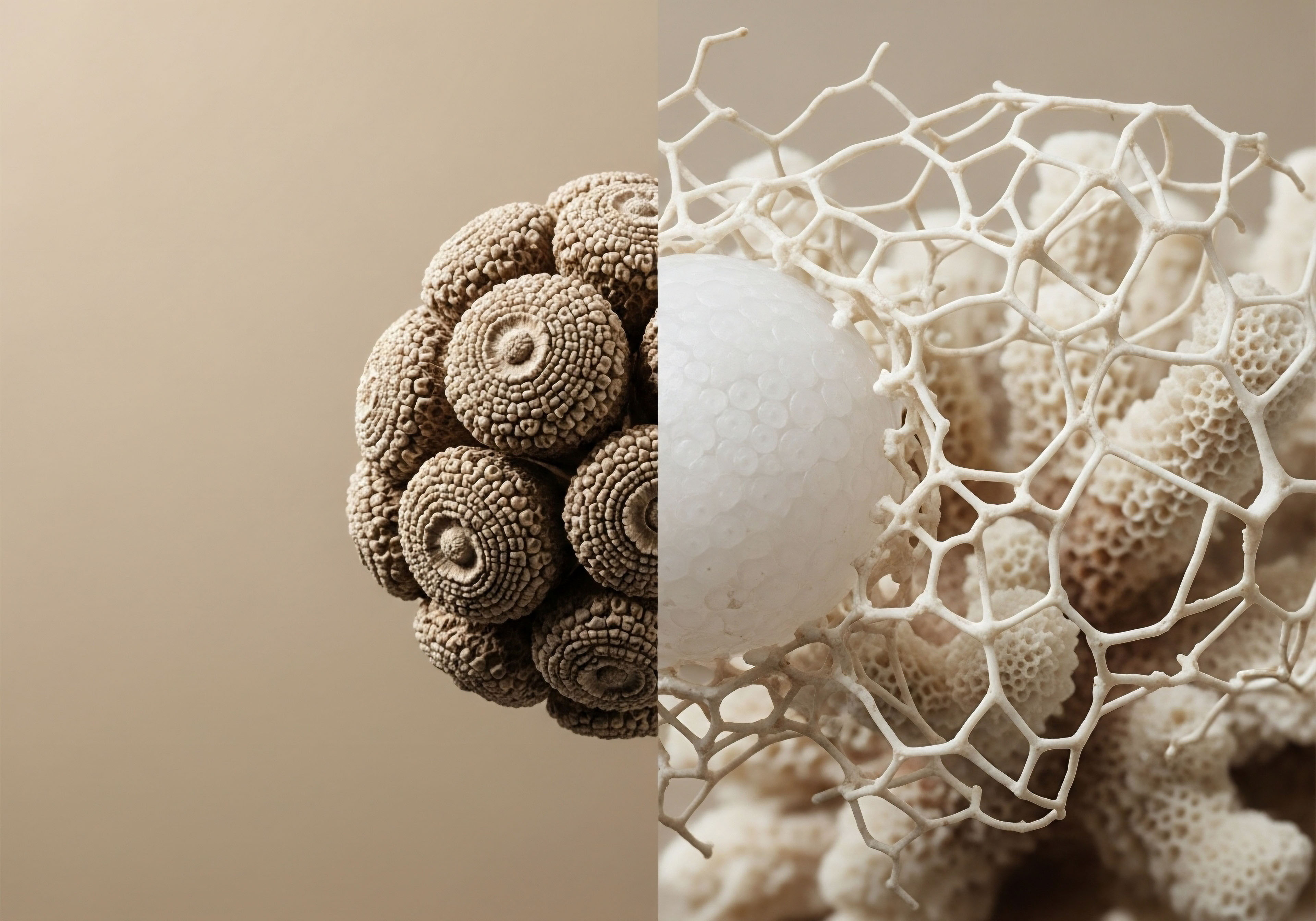

Fundamentals
Experiencing shifts in your body’s internal rhythms can feel disorienting. Perhaps you notice a persistent fatigue that no amount of rest seems to resolve, or a diminishing drive that once defined your days. Many individuals report changes in their mood, sleep patterns, or even their physical composition, leading to a quiet frustration about a vitality that seems to slip away.
These experiences are not simply “getting older”; they often signal deeper biological adjustments within your endocrine system, the intricate network of glands that produce the hormones governing nearly every bodily process. Recognizing these shifts is the first step toward reclaiming your well-being.
Hormone pellets represent a method for delivering specific biochemical messengers to your system, aiming to restore balance when natural production declines. This approach involves placing small, rice-sized pellets, typically containing bioidentical hormones, beneath the skin. The body then absorbs these hormones steadily over several months.
This steady release contrasts with daily applications or injections, offering a consistent level of hormonal support. The goal remains to align your internal chemistry with optimal physiological function, addressing the underlying causes of your symptoms rather than merely masking them.

The Body’s Chemical Messengers
Your body communicates through a sophisticated system of chemical signals. Hormones serve as these vital messengers, traveling through the bloodstream to target cells and tissues, instructing them on various functions. Consider them as the body’s internal communication network, ensuring that all systems operate in concert. When these signals become weak or imbalanced, the entire network can experience disruptions, leading to the array of symptoms many individuals report.
Testosterone, for instance, is a hormone often associated with male physiology, yet it plays a significant role in both men and women. In men, it supports muscle mass, bone density, red blood cell production, and a healthy libido. For women, even in smaller quantities, testosterone contributes to bone health, cognitive sharpness, and sexual desire. Declines in this hormone, whether due to age or other factors, can manifest as reduced energy, changes in body composition, and diminished mental clarity.
Hormone pellets offer a consistent, long-term method for delivering essential biochemical messengers to support systemic balance.

Understanding Hormonal Decline
Hormonal production naturally changes throughout life. For men, testosterone levels typically begin a gradual decline after age 30, a process sometimes referred to as andropause. Women experience more dramatic hormonal shifts during perimenopause and menopause, characterized by fluctuating and then significantly reduced levels of estrogen and progesterone. These natural transitions can bring about a range of challenging symptoms, from hot flashes and sleep disturbances to mood variations and reduced bone density.
Beyond natural aging, other factors can influence hormonal balance. Chronic stress, environmental exposures, certain medical conditions, and lifestyle choices can all impact the endocrine system’s ability to produce and regulate hormones effectively. Addressing these contributing elements alongside targeted hormonal support provides a comprehensive path toward renewed well-being.

Why Consider Pellet Therapy?
The consistent delivery mechanism of hormone pellets offers distinct advantages for many individuals. Unlike daily creams or weekly injections, pellets provide a steady state of hormone levels, avoiding the peaks and troughs that can occur with other administration methods. This stability can lead to more consistent symptom relief and a greater sense of well-being. The convenience of not needing daily or weekly applications also appeals to many seeking a less burdensome therapeutic regimen.
The decision to pursue any form of hormonal support, including pellet therapy, begins with a thorough evaluation of your unique physiological state. This involves detailed discussions about your symptoms, a review of your medical history, and comprehensive laboratory testing to assess your current hormone levels. This initial assessment establishes a baseline and helps determine the most appropriate course of action for your specific needs.


Intermediate
Moving beyond the foundational understanding of hormonal changes, we consider the specific clinical protocols that guide the safe and effective use of hormone pellets over time. The administration of these biochemical agents requires a precise, individualized approach, grounded in a thorough assessment of each person’s unique physiology and health objectives. This section details the systematic steps involved, from initial evaluation to ongoing monitoring, ensuring therapeutic efficacy and patient safety.

Initial Patient Selection and Assessment
The journey toward hormonal optimization with pellets begins with a rigorous selection process. Clinicians evaluate candidates based on a comprehensive review of their medical history, current symptoms, and specific health goals. This initial phase aims to identify individuals who will most likely benefit from pellet therapy while minimizing potential risks. A detailed discussion covers past medical conditions, medication use, and any family history of endocrine disorders or cancers.
Laboratory testing forms a cornerstone of this assessment. Blood panels measure various hormone levels, including total testosterone, free testosterone, estradiol, progesterone (for women), sex hormone-binding globulin (SHBG), and markers of metabolic health. These baseline measurements provide a precise snapshot of the individual’s endocrine status, guiding the initial dosing strategy. For men, prostate-specific antigen (PSA) levels are also assessed, and for women, mammograms and gynecological evaluations are considered.
Rigorous patient selection and comprehensive laboratory testing are fundamental to safe hormone pellet therapy.

Pellet Insertion Protocol
The insertion of hormone pellets is a minor in-office procedure. After local anesthesia is administered to a small area, typically in the upper gluteal region, a tiny incision is made. The pellets are then inserted into the subcutaneous fat using a specialized trocar. The incision is then closed, often with sterile strips. This placement allows for a slow, consistent release of hormones directly into the bloodstream, mimicking the body’s natural secretion patterns more closely than other methods.
The precise dosage and type of hormone pellet (e.g. testosterone, estradiol) are determined by the individual’s baseline lab results, symptom presentation, and clinical judgment. For instance, a man experiencing symptoms of low testosterone might receive a testosterone pellet, while a post-menopausal woman might receive a combination of testosterone and estradiol pellets, with progesterone prescribed separately if indicated.

Ancillary Medications and Their Purpose
Alongside hormone pellets, certain ancillary medications may be prescribed to optimize outcomes and manage potential side effects. These agents play specific roles in modulating the endocrine system’s response to exogenous hormones.
- Anastrozole ∞ This medication is an aromatase inhibitor. It reduces the conversion of testosterone into estrogen within the body. While estrogen is essential, excessive levels in men can lead to side effects such as gynecomastia (breast tissue development) or fluid retention. In women, anastrozole may be used in specific contexts to manage estrogen levels.
- Gonadorelin ∞ For men undergoing testosterone optimization, gonadorelin may be administered via subcutaneous injections. This peptide stimulates the pituitary gland to release luteinizing hormone (LH) and follicle-stimulating hormone (FSH), thereby helping to maintain natural testicular function and sperm production, which can be suppressed by exogenous testosterone.
- Progesterone ∞ This hormone is frequently prescribed for women, particularly those in perimenopause or post-menopause, often in conjunction with estrogen or testosterone. Progesterone helps balance the effects of other hormones, supports uterine health, and can contribute to improved sleep and mood.
- Enclomiphene ∞ This selective estrogen receptor modulator (SERM) can be used in men to stimulate the body’s own testosterone production by blocking estrogen’s negative feedback on the pituitary gland, leading to increased LH and FSH secretion. It serves as an alternative to gonadorelin for some individuals aiming to preserve fertility or endogenous production.

Ongoing Monitoring and Adjustment
Regular monitoring is a non-negotiable aspect of safe hormone pellet therapy. Follow-up appointments are scheduled to assess symptom improvement, evaluate any side effects, and conduct repeat laboratory testing. The frequency of these evaluations varies but typically occurs several weeks after the initial insertion and then periodically based on the individual’s response and pellet longevity.
Blood tests during follow-up assess hormone levels to ensure they remain within optimal physiological ranges. Adjustments to the pellet dosage or the inclusion of ancillary medications are made based on these results and the patient’s clinical presentation. This iterative process ensures that the therapy remains tailored to the individual’s evolving needs, reflecting the dynamic nature of the endocrine system.

How Do Clinical Protocols Guide Long-Term Pellet Use?
Long-term safety and efficacy depend on adherence to established clinical protocols. These guidelines dictate the frequency of re-insertion, the ongoing monitoring parameters, and the criteria for adjusting or discontinuing therapy. They emphasize the importance of maintaining hormone levels within a healthy physiological window, avoiding supraphysiological (excessively high) concentrations that could lead to adverse effects. Regular check-ups allow for early detection and management of any deviations from the desired therapeutic state.
Consider the analogy of a finely tuned instrument. Your body’s endocrine system requires precise calibration. Hormone pellets, when guided by careful clinical oversight, act as a consistent tuner, helping to maintain that optimal pitch. Without regular checks and adjustments, even the most well-intentioned intervention could lead to disharmony.


Academic
A deep examination of hormone pellet therapy necessitates an academic lens, focusing on the intricate physiological mechanisms, pharmacokinetic profiles, and the rigorous clinical evidence supporting its long-term application. This section dissects the scientific underpinnings of pellet-based hormonal recalibration, emphasizing the systems-biology perspective and the precise modulation of endocrine axes.

Pharmacokinetics and Bioavailability of Pellets
The unique pharmacokinetic profile of subcutaneous hormone pellets distinguishes them from other delivery methods. Once inserted into the adipose tissue, the crystalline hormone (e.g. testosterone, estradiol) undergoes a slow, continuous dissolution. This process is influenced by factors such as blood flow to the insertion site, the surface area of the pellet, and the individual’s metabolic rate.
The steady-state release minimizes the diurnal fluctuations often seen with oral or transdermal preparations, and the supraphysiological peaks associated with large bolus injections.
This sustained release results in more stable serum hormone concentrations over several months, typically three to six months, depending on the individual and pellet dosage. The direct absorption into the systemic circulation bypasses first-pass hepatic metabolism, a significant advantage over oral hormone administration, which can place a greater burden on the liver and alter the production of various hepatic proteins, including clotting factors and sex hormone-binding globulin. The consistent bioavailability contributes to the observed clinical benefits and a more predictable therapeutic response.
Subcutaneous hormone pellets offer a stable, sustained release profile, bypassing hepatic metabolism for consistent systemic delivery.

Modulation of the Hypothalamic-Pituitary-Gonadal Axis
Exogenous hormone administration, including pellet therapy, directly influences the Hypothalamic-Pituitary-Gonadal (HPG) axis through negative feedback loops. The hypothalamus releases gonadotropin-releasing hormone (GnRH), which stimulates the pituitary gland to secrete luteinizing hormone (LH) and follicle-stimulating hormone (FSH). These gonadotropins then act on the gonads (testes in men, ovaries in women) to produce endogenous sex hormones.
When exogenous testosterone or estradiol is introduced via pellets, the elevated serum levels signal back to the hypothalamus and pituitary, suppressing the release of GnRH, LH, and FSH. This suppression can lead to a reduction in endogenous hormone production. For men, this means decreased testicular testosterone synthesis and potentially impaired spermatogenesis. For women, it can influence ovarian function.
Clinical protocols often incorporate strategies to mitigate this suppression, particularly in men concerned with fertility or long-term testicular function.
| Agent | Mechanism of Action | Clinical Application |
|---|---|---|
| Gonadorelin | GnRH agonist, stimulates pituitary LH/FSH release. | Maintains testicular size and endogenous testosterone production during exogenous testosterone therapy. |
| Enclomiphene | Selective Estrogen Receptor Modulator (SERM), blocks estrogen negative feedback at pituitary. | Increases endogenous LH/FSH, thereby stimulating testicular testosterone production, often used for fertility preservation. |
| Anastrozole | Aromatase inhibitor, reduces testosterone to estrogen conversion. | Prevents excessive estrogen levels, which can also contribute to HPG axis suppression and side effects like gynecomastia. |

Long-Term Safety and Metabolic Considerations
The long-term safety of hormone pellet therapy is a subject of ongoing clinical investigation, with protocols emphasizing continuous monitoring to mitigate potential risks. Maintaining physiological hormone levels is paramount. Supraphysiological dosing, which means hormone levels exceeding normal ranges, can lead to adverse effects, including erythrocytosis (increased red blood cell count), dyslipidemia, and potential cardiovascular implications.
Regular assessment of complete blood count (CBC), lipid panels, and liver function tests is integral to long-term management. For men, consistent monitoring of prostate-specific antigen (PSA) is a standard practice, given the historical concerns regarding testosterone and prostate health. Current evidence suggests that testosterone replacement therapy in men with hypogonadism does not increase the risk of prostate cancer or high-grade prostate cancer, but careful monitoring remains a clinical standard.
In women, the long-term use of estrogen and testosterone requires careful consideration of breast health and endometrial safety. Protocols often include regular mammograms and, for women with a uterus, the co-administration of progesterone to protect the endometrium from estrogenic stimulation. The precise balance of these hormones is critical to minimizing risks while maximizing therapeutic benefits.

What Are the Biomarkers for Optimal Hormonal Balance?
Beyond measuring the hormones themselves, a comprehensive assessment of optimal hormonal balance involves evaluating a spectrum of biomarkers. These markers provide insights into the systemic impact of hormone therapy and overall metabolic health.
| Biomarker Category | Specific Tests | Clinical Relevance |
|---|---|---|
| Hormone Levels | Total Testosterone, Free Testosterone, Estradiol, Progesterone, SHBG, DHEA-S, Cortisol | Direct assessment of hormone status and availability. |
| Metabolic Health | Fasting Glucose, HbA1c, Insulin, Lipid Panel (HDL, LDL, Triglycerides), hs-CRP | Indicators of metabolic function, insulin sensitivity, and systemic inflammation, all influenced by hormonal status. |
| Hematological Markers | Complete Blood Count (CBC), Hematocrit, Hemoglobin | Monitors red blood cell production, particularly important with testosterone therapy to detect erythrocytosis. |
| Bone Health | Bone Mineral Density (DEXA scan), Vitamin D, Calcium | Assesses skeletal integrity, which is significantly influenced by sex hormones. |
The interplay between sex hormones and metabolic function is complex. Testosterone influences insulin sensitivity and body composition, while estrogen plays a role in lipid metabolism and cardiovascular health. Monitoring these interconnected systems allows clinicians to fine-tune therapeutic regimens, aiming for not just symptomatic relief but also a broader improvement in metabolic resilience and overall physiological function. This systems-based approach ensures that hormone pellet therapy is integrated into a comprehensive wellness strategy, rather than viewed as an isolated intervention.

References
- Traish, Abdulmaged M. et al. “Testosterone and prostate cancer ∞ an update of the literature.” Asian Journal of Andrology 19.3 (2017) ∞ 285.
- Glaser, Rebecca, and Constantine K. Dimitrakakis. “Testosterone pellet implants for men ∞ a clinical review.” Clinical Interventions in Aging 10 (2015) ∞ 1699.
- Davis, Susan R. et al. “Global Consensus Position Statement on the Use of Testosterone Therapy for Women.” Journal of Clinical Endocrinology & Metabolism 104.10 (2019) ∞ 3459-3467.
- Santoro, Nanette, et al. “Perimenopause ∞ From Basic Science to Clinical Management.” Endocrine Reviews 34.6 (2013) ∞ 839-879.
- Guyton, Arthur C. and John E. Hall. Textbook of Medical Physiology. 13th ed. Elsevier, 2016.
- Boron, Walter F. and Emile L. Boulpaep. Medical Physiology. 3rd ed. Elsevier, 2017.
- Handelsman, David J. “Testosterone ∞ A History of Its Use and Abuse.” Current Opinion in Endocrinology, Diabetes and Obesity 20.3 (2013) ∞ 195-203.
- Shifren, Jan L. and Susan R. Davis. “Androgens in women.” Journal of Clinical Endocrinology & Metabolism 98.10 (2013) ∞ 3469-3477.

Reflection
Understanding your body’s intricate hormonal systems is a profound act of self-discovery. The knowledge presented here, from the foundational roles of biochemical messengers to the precise clinical protocols guiding pellet therapy, offers a framework for comprehending the shifts you may experience. This information serves as a starting point, a map to help you orient yourself within your own physiological landscape.
Your personal health journey is unique, shaped by your individual biology, lifestyle, and experiences. The insights gained from exploring these clinical considerations are not a destination, but rather an invitation to engage more deeply with your own well-being. Consider how this information resonates with your own symptoms and aspirations for vitality. The path to reclaiming optimal function often begins with informed questions and a commitment to personalized guidance.



